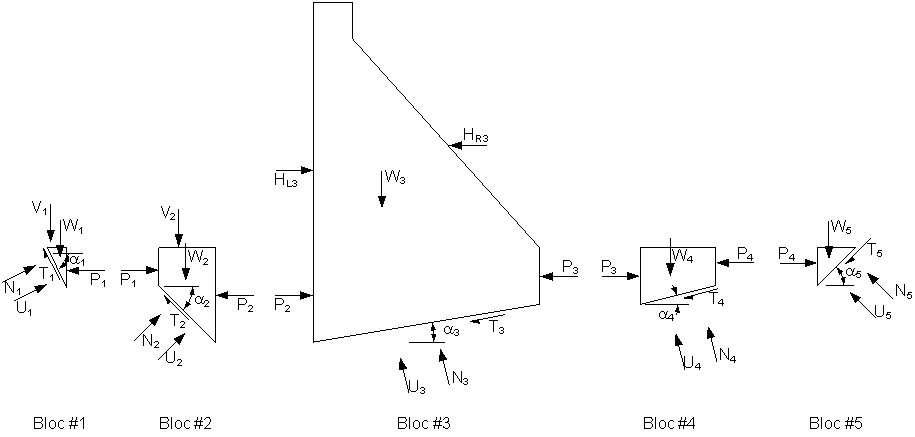Failure analysis of the foundation (multiple-wedge analysis)
At the foundation level, sliding stability along cracks, faults or areas with pervious stratum should be considered in the analysis. The mechanical characteristics of these faults or cracks can vary significantly within the foundation. To evaluate the sliding stability at the failure planes in the foundation, CADAM3D uses a limit equilibrium method known as "multiple-wedge analysis".
This method calculates the sliding safety factor required to initiate the simultaneous failure of all planes in the foundation. This method is based on the horizontal equilibrium between the foundation blocks and is described in detail in Gravity Dam Design (USACE, 1995).
CADAM3D evaluates the full uplift pressure assuming a uniform head loss between the upstream face and the downstream outlet of the failure planes. Some cracks with pervious stratum are subjected to full uplift pressure, without loss of load, due to their excessive permeability.
Figure 22 provides an example to illustrate the methodology.

Figure 22
The system in Figure 22 is broken down into 5 separate blocks: two loading blocks (#1 and #2 blocks), one structural block (#3 block) and two resistance blocks (#4 and #5 blocks), as shown in Figure 23.

Figure 23
The general equation is described by the equilibrium of the normal (Ni) and tangential (Ti) forces at the break-up planes from which the factor of safety FS is obtained from:
![]() , i = block number analysed
, i = block number analysed
![]()
Solving for (Pi-1 - Pi), the following equation is obtained for each block:

where : ![]() , ϕi = friction angle under bloc i
, ϕi = friction angle under bloc i
![]() , ci = cohésion for bloc i
, ci = cohésion for bloc i
The value of the Sliding Safety Factor (SSF) can then be modified so that the sum of the (Pi-1 – Pi) of all blocks converges to zero. The user first determines the geometry of the failure plane (segments). Subsequently, CADAM3D initialises a SSF = 100. Then, an iterative process is used (bisection method) to satisfy the horizontal equilibrium of the forces involved.